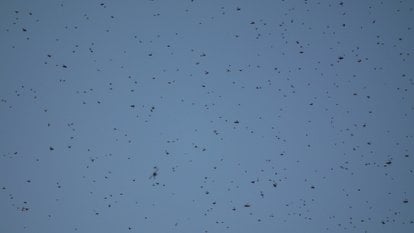Locust Plague in Egypt 2026
When you see a swarm of hungry, angry locusts, better stay out of their way!
Best time: late February–March
When locusts migrate en masse, observing this spectacle is better from far away—preferably in the safety of your car seat. But if such a swarm bumps into your face, it wouldn't be a pleasant experience. Normally solitary creatures, desert locusts tend to come together after a drought season, followed by heavy rainfall, looking for food and demolishing all the crops in their path.
Locusts Swarming Season
The country annually sees similar occurrences, but not always so massive. The insect armies activate in the dry season, when food is scarce, typically in late February through March for Egypt. Once the drought is over and the land is blessed with rain, which causes vegetation and crops to grow, locusts frantically flock together and form aggressive groups.
Migration Patterns & Behavior
The locusts swarm are mainly triggered by weather conditions and lack of food sources. After the rainfall, once the crops start to grow, serotonin kicks in in their brain, causing them to breed frantically, group together, and migrate to areas with more vegetation. Overcrowding is also said to be one of the causes of swarming. Tactile contact with their hind legs again releases more serotonin in their brain, and is also why they keep moving forward.
During this aggressive phase, locusts might even attack and eat each other, meaning that they interpret any tactile contact against their legs as an attack. This is also one of the causes of their physical transformation. Desert locusts, which are typically brown when solitary, change color as they gather in large groups. Immature locusts take on a pink color, while mature ones turn yellow.
Where to See Locusts
Migratory locusts can be seen mainly across Northern Africa and also western Asia. Major swarms were recorded on the coast of the Red Sea and the Gulf of Aden near Yemen. The coast of southeast Egypt and the banks of the Nile River also experience large groups of locusts. The clouds of these insects have been seen in the sky above Cairo. Food and Agriculture Organization of the United Nations regularly publishes briefs on the recent locust outbreaks and upsurges, as well as their breeding and fledging process.
Dangers of Locust Swarm
Relatively recent reports of locust plagues testify that migration causes severe problems for the local population and damages agriculture. These hungry insects are determined to eat everything on their way. A huge swarm of 80 million locusts is capable of demolishing food sources, enough for 35,000 people. As of right now, the population of locusts is largely controlled with the help of insecticides, surveillance, and other modern control practices.
Other Locust Plague Instances
The most impressive invasions of not millions, but rather billions of locusts occurred in Egypt in March 2013. Desperate Egyptians were even forced to burn tires to ward off these fearless insects. Another outbreak happened back in 2004 when locusts migrated from Northern Africa and were able to reach Portugal. In 2020-2021, one of the largest locust upsurges broke out in Eastern Africa, particularly Northern Kenya, near the Red Sea, and Southwest Asia.











































































